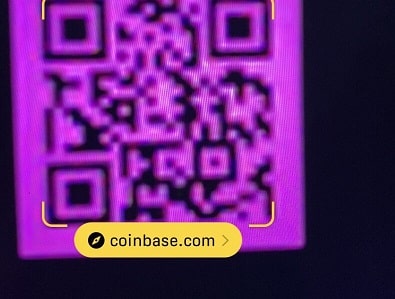But the commercial was controversial for another reason - it generated so many scans in those 60 seconds the advertiser's website crashed. Think about that: an on-air QR code scanned so frequently, by so many people, their servers crashed. If you've been around Internet marketing for any length of time, you know when servers crash from a Super Bowl ad, some inflection point has been reached that's worth paying attention to. Last night, QR codes showed they have what it takes to connect with mobile consumers at the largest scale there is.
Here are 7 lessons and takeaways we saw in Coinbase's QR ad:
1) They used a low-density, simple design for easy scanning
First, don't outsmart yourself or let designers go crazy with logos and complex shapes and QR designs. Basic QR codes are recognizable by mobile consumers now. Second the QR code destination URL was short enough that it produced a low density QR code, this is what made it easily scannable from the couch.
Adding logos or cool shapes and designs to QR codes often make the “data pixels” smaller and harder for phones to read. Always optimize for scans not beauty and will deliver the best experience for your audience.
2) They optimized for distance making the QR scannable from the couch
QR codes are like simple 2D boxes but distance is a third dimention critical to optimize for maximum scanning. In this case, we are on our couches 10-15 feet away from our TV screen. For a QR to be scannable from that range requires significant screen real estate dedicated the QR code display size especially because a wide range of phone types and cameras would be used for scanning.
Coinbase displayed the QR large enough on screen to be scannable for most viewers. To free up space on the screen, they made the QR the center of attention which was a brilliant way to avoid any competing visual.
3) They gave TV viewers enough time to scan
One of the mistakes TV marketers often make on air is displaying the QR too briefly. It takes time for the ad to generate enough interest in scanning the QR. Keep the QR on the screen long enough to give consumers time to think about the benefit of scanning and time to pull out their phone to scan.
Too often TV viewers don’t bother because the QR code on screen is displayed too briefly. Coinbase (famously now) displayed their QR code for a full 60 seconds.
4) They created a compelling reason to scan
Focus your creativity on the ad itself. In this case, the bouncing QR was the ad and it was onscreen alone, without context which changed any preconceptions of how a Super Bowl ad can be interactive. Curiosity compelled us to scan. It was a genius way to catch the attention of a prime time audience – while balancing other requirementslike time on screen.
The ad worked. Think about how you can you get people to be curious about what lives behind your QR code? Think about your call to action. Sell your audience the benefits of your product or service.
5) They
As consumers, we have all seen unfamiliar QR code domains unrelated to the brand which inspires questions about privacy. Coinbase went a step further and encoded their own URL for the QR code which provided a signal boost that ultimately drove 20 million users to their site.
Coinbase basically leveraged their domain as an extension of the ad – revealing brand context which was absent in the ad. When implementing any QR codes campaign for apps or websites, make sure the link shows your brand's domain.
6) They made the campaign 100% trackable
Their QR appended the tag '?qr' at the end of the URL. This allowed the Coinbase website to attribute online signups and activity back to the TV ad. QR codes let you attribute scans to any channel even TV. This illustrates what makes QR codes such a powerful part of the ad tech stack – not only do they offer a way to engage mobile consumers at scale, they also offer marketers a way to make offline and on-air media accountable.
Just be careful not to add so many tracking parameters that it bloats your QR into a high density code that is unscannable for users.
7) The QR code opened the coinbase app
Scanning the QR routed you to a mobile landing page with buttons for new and existing users. New users who wanted to try the offer were routed to the iOS or Android app store to install the Coinbase app. Existing app users were routed to a different page that took you into the Coinbase app.
One missed opportunity to point out: the link behind the QR could have included the deep link logic to open the app to a relevant screen if it was already installed, rather than forcing them to make additional clicks on the web landing page.
Coinbase’s Super Bowl ad showed the world how powerful QR codes can be at generating mobile engagement with massive audiences. (The ad is credited with rocketing Coinbase's app to the top of the iOS app store.) If they hadn’t already done so, last night QR codes cemented a starting role in the ad tech stack.
Need help incorporating QR codes into your marketing strategies and campaigns? Check out these additional resources and posts, or feel free to get in touch with our QR marketing experts!
